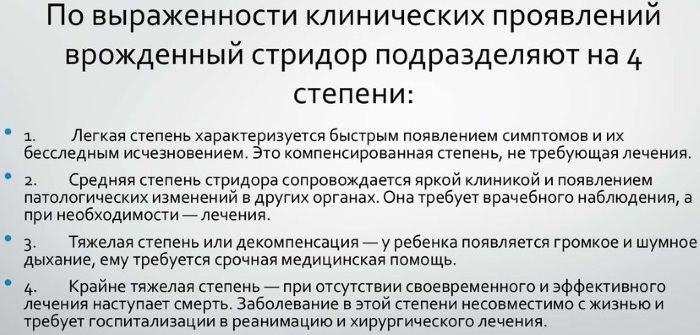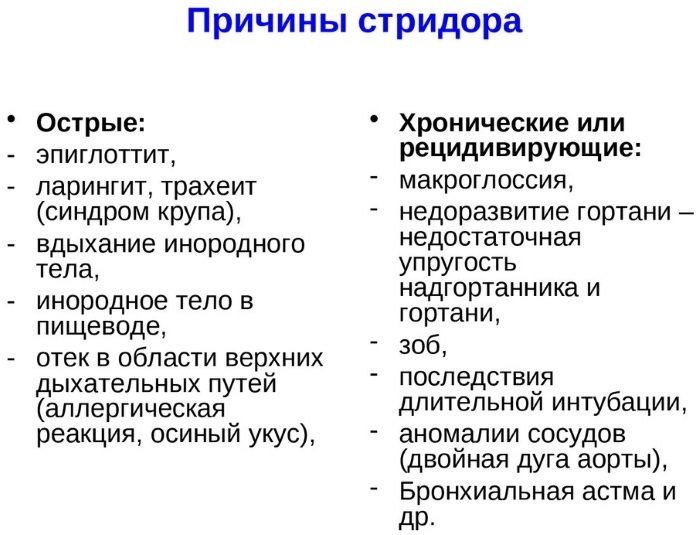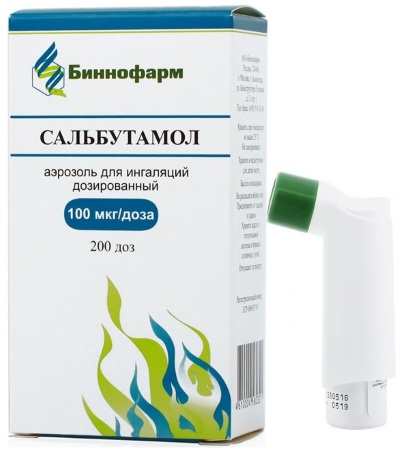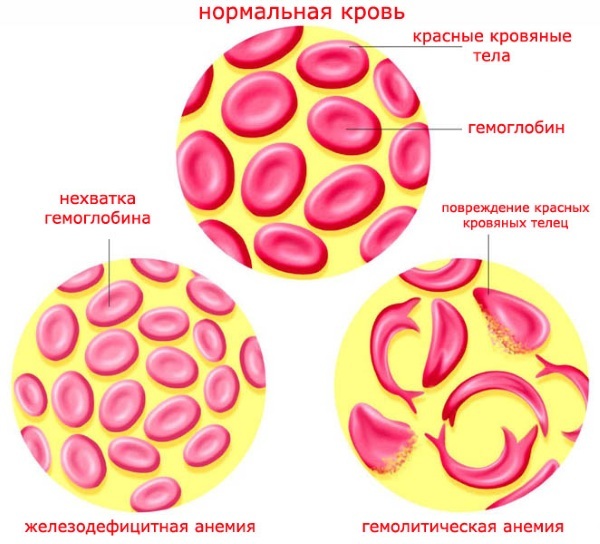Baby stridor - This is a narrowing of the upper respiratory tract against the background of certain pathological processes. Respiratory obstruction is accompanied by noise, whistling, creaking. In most cases, the child does not need treatment, but the consultation of a pediatrician is necessary. It is important to exclude the development of a serious illness and the occurrence of complications in the baby.
Record content:
- 1 Views
- 2 Stages and degrees
- 3 Symptoms
- 4 Reasons for the appearance
- 5 Diagnostics
- 6 When to see a doctor
- 7 Prophylaxis
-
8 Treatment methods
- 8.1 Medications
- 8.2 Other methods
- 9 Possible complications
- 10 Stridor video
Views
Stridor in infants is often identified due to the anatomical features of the respiratory organs. The cartilage in the larynx region of the baby is not fully formed, soft. Therefore, when the baby breathes in air, they close and vibrate under the influence of pressure from the walls of the bronchi. A frequent occurrence that is diagnosed in newborns in 1.5-4% of cases.
There are the following forms of respiratory obstruction:
| Name | Description |
| Inspiratory | The condition is characterized by a heavy breath and a low sound. The lesion is located on top of the vocal cords. |
| Expiratory | There is a heavy breath and a moderate noise level. The audibility of the sound increases, the baby feels discomfort. The pathological focus is located below the vocal cords. |
| Mixed | The most severe form of strider, in which inhalation and exhalation are disturbed. The child is worried about severe discomfort, since the pathological focus is in the area of the vocal cords. The baby's breathing is disturbed, it becomes heavy and noisy. |
Careful observation of the child will help to determine the form of respiratory obstruction, preferably by a qualified pediatrician.
If you carefully understand such an effect as Venturi, you can find out that when air moves forward along a narrowed object, its lateral pressure decreases.
Due to this phenomenon, the airways remain open when a person breathes. The reduced pressure at the time of the passage of the air flow through the narrowed section of the flexible duct leads to the fact that an obstacle appears. In this situation, a characteristic sound called stridor occurs.
In newborn babies, a certain classification of air obstruction is distinguished, taking into account the cause of the pathological condition:
| Name | Description |
| Spicy | It is diagnosed more often in babies from 6 months. Among the provoking causes, stenosing laryngotracheitis, inhalation of a foreign body, abscesses, anaphylactic shock, epiglottitis are distinguished. |
| Chronic | In most cases, chronic respiratory obstruction occurs against the background of congenital abnormalities. This includes vocal cord dysfunction, laryngomalacia, and subglottic stenosis. The same goes for congenital malformations of the larynx and tracheomalacia. |

To make an accurate diagnosis and draw up the correct treatment regimen, the pediatrician needs to know from what the moment a respiratory obstruction appeared in the child, how long does it last and what concomitant symptoms. The specialist also takes into account the course of labor during the birth of the baby.
Stages and degrees
In most cases, after 12 months, the stridor in an infant goes away on its own. Sometimes he indicates the development of a serious disease when the baby needs therapy.
There are the following stages of strider in infants:
| Name | Description |
| Compensated | A light form of a strider, when it occurs, the baby does not feel discomfort. Clinical signs of a pathological condition are rare. As the child grows up, the situation stabilizes on its own. Treatment in this case is not carried out. |
| Border-compensated | At this stage, the baby's stridor does not bother much. But he needs the supervision of a pediatrician in order to timely detect pathological changes and prevent complications. |
| Decompensated | During inhalation, the child has a loud noise and whistle. At this stage, not only the supervision of a specialist is necessary, but also a specially selected drug treatment. |
| Critical | Breathing is severely impaired at this stage. The child needs surgery. The risk of death of the little patient remains high. |

Timely diagnosis and monitoring of the patient's condition will help to respond to any changes in the baby's condition. The treatment is carried out by a pediatrician.
Symptoms
In infants, the manifested clinical symptoms of stridor will help the specialist to establish the stage of the disease and area of localization of pathological processes:
| Name | Symptoms |
| Weak form of stridor |
|
| Severe form |
|
The main clinical sign of stridor in infants is wheezing, which appears during inhalation and exhalation. In the first case, the symptom indicates an inspiratory form of pathology. When exhaling, wheezing indicates the presence of an expiratory stridor. Mixed respiratory obstruction is accompanied by a constant murmur.
Symptoms change when the baby screams and cries, also when the body position changes. In some situations, noise is present even during sleep. The general condition of the baby is satisfactory, his activity is not disturbed.
Viral and bacterial infections increase stridor in newborn babies. Mucous membranes swell, breathing worsens. An infectious lesion of the body is accompanied by respiratory failure, severe shortness of breath and attacks of suffocation. The skin also turns blue, blood pressure rises, the baby becomes restless.
Severe stridor can be life-threatening for a child. In this situation, the patient needs urgent hospitalization and medical intervention.
Reasons for the appearance
Stridor in infants occurs as a result of poorly developed laryngeal cartilage. They are soft and vibrate as air passes through the airways, resulting in noise.
In the absence of serious complications and other diseases, the symptomatology of the pathological condition gradually decreases. Improvements are observed every month. In such a situation, by the age of three, the baby is fully recovering, and the parents forget about the stridor.
But there are provoking factors, against the background of which respiratory obstruction appears, and even intensifies:
| Name | Description |
| Enlargement of the thyroid gland from birth | A large gland puts pressure on the larynx, resulting in a characteristic noise. |
| Laryngotracheoesophageal fissure | A pathological congenital condition in which the larynx and trachea are enlarged. Moreover, they also merge with the esophagus. The main cause of this defect is the incompletely fused dorsal part of the cricoid cartilage. |
| Membrane scarring | A congenital and dangerous disease characterized by a narrowing of the laryngeal gap during breathing. A mild form of pathology is not dangerous to humans. Severe scarring provokes numerous complications, including death. |
| Congenital changes | We are talking about an enlarged goiter or a weak glottis. Congenital abnormal features in babies associated with the respiratory system can be cured in the early stages with the help of drug therapy. |
| Thymus enlargement | The pathological condition often occurs against the background of iodine deficiency in the child's body. |
| Laryngeal cyst | The neoplasm grows, while putting pressure on the airways or the soft tissues of the esophagus. A cyst can appear in the epiglottis, supraglottic or subglottic region, as well as in the scapular laryngeal fold. Treatment is carried out by surgery. In some situations, the risk of recurrence of the cyst remains. |
| Damage to the central nervous system | Diseases lead to an increase in the tone of the respiratory muscles. In some situations, the child's lower and upper limbs tremble during breathing with damage to the central nervous system. |
| Premature birth of a baby | The child's body is not fully matured physiologically. The soft cartilage in the larynx is sticking together. |
| Vascular ring | Abnormal pathology that affects large vessels. They compress the distal trachea. Respiratory obstruction in this situation is aggravated when the baby is crying or while feeding. The same thing happens while lying on your back. An accurate diagnosis will help to establish a contrast radiography of the esophagus. |
| Neurological disorders | The tone of the laryngeal muscles increases. The vocal cords become constrained and tense, so during breathing, the baby develops a noise. A small patient needs a neurologist's supervision and a properly selected treatment to reduce muscle tone. |
| Tracheal intubation | Stridor in infants often occurs against the background of medical intervention. To prevent negative consequences, it is important to strictly follow all the recommendations of the attending physician in the period after the operation. |
| Acquired diseases | Polyps in the respiratory system contribute to respiratory failure. |

Among the provoking causes that cause stridor in infants, there is also an incompletely developed trachea, weak walls of the larynx. The same goes for the sub-lining hemangioma, a foreign body that has entered the respiratory organs.
Dangerous signs of a pathological condition can lead to serious consequences (cardiac diseases, Down syndrome), therefore, in such a situation, the baby needs an ambulance and qualified doctor's help.
Diagnostics
Timely diagnosis and a properly selected treatment method will help prevent serious complications, including death. Small children are dealt with by a pediatrician. If necessary, the patient may need advice from other specialized specialists (otolaryngologist, neurologist, gastroenterologist, pulmonologist, endocrinologist).
Stridor in infants during breathing and the exact cause of respiratory obstruction help determine the following examination methods:
- microlaryngoscopy;

- X-ray of the chest and larynx in several projections (a diagnostic method that allows you to identify pathological cartilaginous changes);
- endoscopy (a specialist examines the organs of the respiratory system, assesses their condition and identifies pathological changes);
- contrast radiography (the diagnostic method allows you to detect compression of the airways, the formation of fistulas in the trachea and esophagus, the development of gastric reflux);
- general analysis of blood and urine;
- ultrasound examination (ultrasound) of the respiratory tract;
- magnetic resonance imaging (MRI);
- neurosonography;
- computed tomography (CT).
If the cause of the baby's stridor is an enlarged thyroid gland, the patient will need an endocrinologist's consultation and a hormone test. Instrumental diagnostic methods will help identify pathological changes in the larynx, bronchi, trachea, assess the condition of the cartilaginous skeletons.
When to see a doctor
Stridor in infants is not always the result of a pathological condition. In most cases, the baby's breathing is restored on its own. But parents are advised to be very careful, as you can miss a really dangerous illness.
You should consult a doctor immediately when the first signs of stridor appear in order to undergo an examination and make sure that the child's life is safe. If the diagnosis helps to identify a serious disease, then timely treatment will prevent dangerous complications.
Prophylaxis
Stridor in infants passes on its own in most cases by 2 years, when the cartilage in the larynx hardens and the lumen expands.
In this situation, the patient is advised to adhere to secondary prevention, it is enough to remember the following doctor's advice:
- Regularly visit a pediatrician in order to timely identify pathological changes or complications.
- Rationally and correctly feed the baby, if necessary, follow a specially formulated diet.
- Avoid hypothermia, dress for the weather, keep away from colds.
- During viral epidemics, it is necessary to give the child vitamins.
- Moderately temper the body, strengthen the immune system.
- Every day, ventilate the room in which the baby is located.
- Strictly follow all the rules of personal hygiene.
- Treat all respiratory diseases in a timely manner.
It is necessary to walk more with the child in the fresh air. Protect the baby from psycho-emotional outbursts, stress, maintain a calm atmosphere in the family.
Treatment methods
Stridor in infants is treated, taking into account the results of a comprehensive examination and the condition of the baby. The doctor prescribes medications. In most cases, therapy is carried out on an outpatient basis, in rare situations, hospitalization of a small patient is required.
Medications
The doctor selects medicines taking into account all the characteristics of the child's body and the development of a pathological condition. It is important to adhere strictly to the prescribed treatment regimen, since many drugs provoke side effects.
Stridor in infants is treated with the following medications:
| Drug group | Name | Application |
| Bronchodilators | Salbutamol, Eufilin | Medicines help to stop the spasm of the muscles of the respiratory organs. The drug is used in the form of inhalation. The recommended dosage for relieving bronchospasm is 100-200 mcg (1-2 inhalations). The medicine should be used no more than 4 times a day. |
| Hormonal drugs | Hydrocortisone, Dexamethasone | The medicine is taken orally with meals. Children's dosage depends on age and is 2.5-10 mg / m2. The indicated volume of the drug should be divided into 3-4 doses. |
| Decongestants | Furosemide | The tablets should be taken on an empty stomach, swallowed whole and washed down with plenty of liquid. Children's dosage is calculated based on the baby's body weight - 1-2 mg / kg per day. It must be divided into 2-3 doses. |

With an infectious lesion of the child's body, the child is prescribed inhalations. They help relieve spasms and widen the airways. Additionally, children are prescribed humoral immunomodulators, vitamin complexes to increase the body's defenses.
Other methods
In difficult situations or when serious complications appear, the child is shown surgical intervention, in the absence of which the baby may die. Taking into account the causes of the pathological condition and the individual characteristics of a small organism, the surgeon chooses the most effective and safe method of surgical treatment:
| Name | Description |
| Tracheotomy | An operative method of therapy, which is indicated for paralysis of the vocal cords. |
| Laser treatment | This method removes the formed cysts in the larynx region. During the operation, the walls of the organ are dissected using a laser. |
| Intubation | The operation is carried out strictly according to the indications when a critical situation has arisen. |
After surgery, the patient is prescribed medications to prevent possible complications. Regular massage procedures will also improve the baby's condition and eliminate spasms in the respiratory organs.
Possible complications
If a child has a stridor after 12 months and continues to bother the baby, it is imperative to undergo a comprehensive examination and start treatment.
Many pathological factors that cause respiratory obstruction can lead to serious consequences:
| Name | Description |
| Pneumonia | The disease is accompanied by an inflammatory reaction of the lung tissue. In most cases, pathological processes result from an infectious lesion. |
| Laryngitis | The disease is characterized by an inflammatory process in the larynx. The provoking factor is viral or bacterial pathologies. |
| Tracheitis | An inflammatory disease of an infectious nature, in which pathogenic microorganisms affect the mucous membrane of the larynx (staphylococci, streptococci). Pathology is accompanied by dry paroxysmal cough and low-grade fever. |
A cold in combination with a violation of the adaptive mechanisms will lead to respiratory failure. A complication of the pathological stridor is also aphonia, asphyxia and even death due to lack of oxygen.
Parents should understand that stridor in babies cannot always go away on their own. Moreover, respiratory obstruction can be the result of a serious pathology, which must be identified and eliminated in a timely manner. Otherwise, the risk of serious complications remains.
Stridor video
Komarovsky about "stridor":



